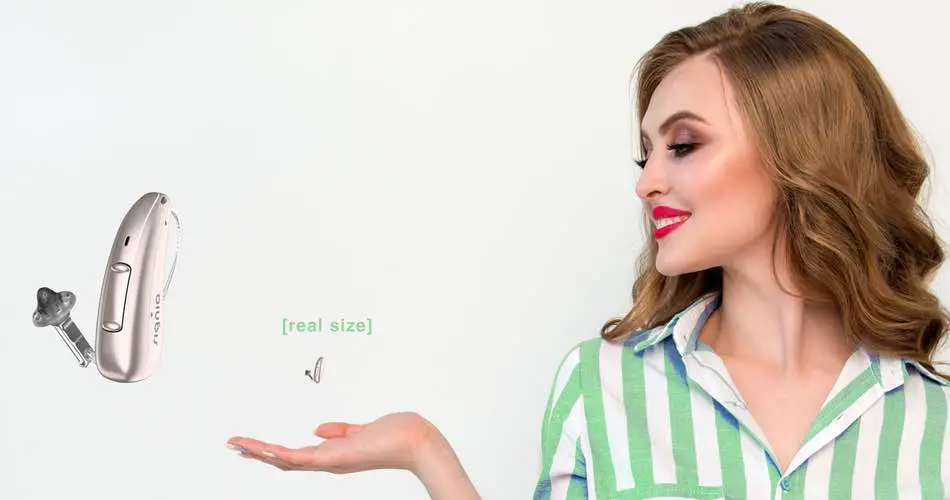Tinnitus and hearing loss are often related. Therefore, wearing a modern hearing aid for tinnitus can be an effective tinnitus treatment. The best hearing aids for tinnitus masking not only amplify external sound but also provide tinnitus therapy that can be customized to compensate for your hearing loss.
The following functions can be enabled with the best hearing aids for tinnitus:
- white noise (static sound)
- sounds of nature like ocean waves or a forsest
- soft music
With this Sound therapy, the additional sound should mask the offending tinnitus sounds. Not all those tinnitus programs work the same for every wearer of hearing aids with tinnitus. This is why it is so important to test various options available. Basically, most of the hearing aids available have some sort of the listed functions above. Here in this article, we will have a closer look at them.
| white/red noise (static sound) | sounds of nature | soft music | |
| Phonak | yes | no | no |
| Starkey | yes | no | no |
| Oticon | yes | yes | no |
| Signia | yes | yes | no |
| Audio Service | yes | yes | no |
| ReSound | yes | yes | no |
| Widex | yes | yes | yes |
As you can see in the table above Widex hearing aids have the most approaches to combat tinnitus. They are a great option. But when it comes to the best hearing aids for you individually testing is the only way to find out what you like the most. While some prefer the melodic tones a lot others may like the notch therapy from Signia more. This is why I listed the manufacturers below and the options you get when it comes to reducing tinnitus so you can find out what the best hearing aids are for you.

Oticon hearing aids for Tinnitus
Generally are all the behind-the-ear hearing aids from Oticon listed below have a tinnitus noise onboard. There are three different types of ocean wave sounds available.
- More
- Open
- Open S
- Siya
- Ruby
In addition to the natural sounds for tinnitus, there is also broadband noise available in the professional software. The hearing care specialist can choose between the options below.
- Noise based on your hearing loss
- White noise
- Red noise
- Rose noise
All those broadband tinnitus options above from Oticon can automatically switch to a little louder or a little quieter. This means they can be modulated in three stages (low, medium, and high modulation). The standard is set to no modulation so the noise stays the same in the background. In comparison, the nature sounds listed above can not be modulated. The nature sounds are also based on a white red and rose noise.
There are also other ways to influence the way the tinnitus program reacts depending on how loud it is around you. For example, some patients with tinnitus are able to forget the ringing in the ear when they are outside because of the added sounds around them and perceive the tinnitus more dominant when they are at home.
With a switch toggle, your hearing care specialist can enable a function to reduce the tinnitus noise automatically when it gets a little louder (above 75db SPL) and makes the tinnitus program again automatically go back to normal when it is quieter around you. If you like to turn off the microphones to hear the environmental sounds less so you only hear the noise from the chosen tinnitus function this is also possible.
This information until now about the tinnitus programs of Oticon was more focused on the behind-the-ear devices. When it comes to the in-the-ear hearing aids the options to look a little different. A button is required when the earing aid getts manufactured. If you choose a configuration without a push-button no tinnitus function can be added by your hearing care professional.
Phonak Hearing Aids for Tinnitus
Tinnitus functions can be enabled with the technology level 30 and above. Less price intense hearing aids do not come with the tinnitus function. Phonak actually only has a white noise which can be enabled in the settings by your hearing care specialist. There are no other sounds available.
Signia Options for Tinnitus
The hearing aids from Signia require a minimum tech level of 2 and above to get a tinnitus function. Less price intense devices like the Intuis models do not come with Tinnitus noises onboard. The older devices which have an NX in their model name distinguished between limited tinnitus functionality between 2 and full tinnitus functionality from tech level 3 and above.
Since the newer models X and AX this difference is not present anymore. What you receive with the full tinnitus functionality is:
- Static noise
- Ocean waves
- Notch therapy
The notch noise filter therapy involves activating a special filter in the hearing system that blocks out the affected frequency range. The aim is to silence this range in order to curb the hyperactivity. During the fitting process, the hearing care specialist identifies where your tinnitus is located. And this very subtle part of the frequency spectrum will get no amplification.
The idea behind this concept is the tinnitus noise should not accumulate with the rest of the noise which stems from the amplification of the hearing aids.
Audio Service
Hearing aids from Audio Service have tinnitus functionality with technology level 6 and above. With the tech level 6 a static noise is all you get. When you go up to technology level 8 and above you get the ocean waves and the notch therapy.
Resound
All hearing aids from Resound have tinnitus functionality. For example, the Enya hearing aid models from Resound have a sound generator onboard but the Lynx 3D, Quattro, or the model key, because you can influence the tinnitus, sounds more in combination with the mobile app and fine-tune it more to your liking.
For example with the connectivity to the mobile app, the tinnitus noise can be individually adjusted in combination with the environmental sounds you normally hear with your hearing aids. As with the other manufacturers to the hearing care specialist has the ability to add the tinnitus functionality to one of your programs.
Starkey
Every Livio hearing aid from Starkey starting with the technology level 1000 has tinnitus functionality. Older devices like the Muse IQ also can be used when it comes to tinnitus. In the devices, only static noise can be enabled. If you use the Livio hearing aids which come with Bluetooth you could also stream natural sounds to your hearing aids.
Of course, this requires streaming and will reduce the runtime of your hearing aids significantly. This is also possible with the devices mentioned by other manufacturers.
Widex
Widex hearing aids have the Zen tones which you get even with the less price-intensive options. What you get are classic static noise or natural sounds to reduce your tinnitus. In addition to both therapies, most manufacturers have Widex also plays a melody if you like which does not repeat itself. This is the Zen tone program.
For most customers, it sounds a bit strange at first to have a melody played. But Widex integrates the zen tones really great to the normal things you hear with your hearing aids so it is not disturbing. Here in the example below, you can listen to the sound samples which you would get when zen tones are enabled.
This melodic approach is proven to reduce tinnitus for a lot of wearers of hearing aids. But you personally need to test it out.
Can a Hearing Aid Reduce Tinnitus?
Hearing aids have the potential for approximately 60% of the wearers of hearing aids to reduce tinnitus. Hearing aids can reduce tinnitus by making them less dominant. In some cases, wearers of hearing aids forget their tinnitus completely.
In some cases, it is enough to just turn the hearing aids on to reduce the tinnitus without a special program that adds sounds to the normal environmental sounds. But in other cases, a classic static swoosh works best while other wearers of hearing aids like ocean waves or the sounds of a forest reduce tinnitus.
Can Tinnitus Be Worse With Hearing Aids?
Hearing aids in some cases can make tinnitus worse. In a survey done with 230 hearing care professionals, only 1.75% of the wearers with tinnitus fitted with hearing aids experienced a worsening of their tinnitus. This worsening is temporary. When the hearing aids are not worn anymore the tinnitus goes back to normal again.
What Is the Most Effective Treatment for Tinnitus?
The most effective treatment is highly dependent on the person with tinnitus individually. What works for some people does not work at all for others. This is why it is important to have look at the options below with your hearing care specialist so he or she can talk with you about what might be appropriate for you.
- tinnitus management strategies
- hearing aid
- behavioral therapy
- sound therapy
- antidepressants
- zinc, or other dietary supplements
- transcranial magnetic stimulation
Depending on how severe your hearing loss and tinnitus are the options range from getting more relaxation and not focusing on the ringing noise to devices like hearing aids or cochlear implants.
